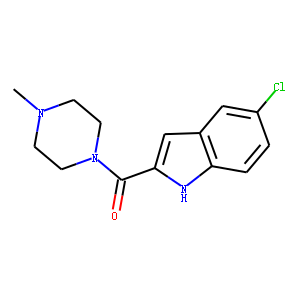| Reference | 1. Naunyn Schmiedebergs Arch Pharmacol. 2013 Nov;386(11):983-90. doi: 10.1007/s00210-013-0898-4. Epub 2013 Jul 3.<br />
The dual H3/4R antagonist thioperamide does not fully mimic the effects of the 'standard' H4R antagonist JNJ 7777120 in experimental murine asthma.<br />
Neumann D(1), Beermann S, Burhenne H, Glage S, Hartwig C, Seifert R.<br />
Author information:<br />
(1)Institute of Pharmacology, Hannover Medical School, Carl-Neuberg-Str. 1, 30625, Hannover, Germany, [email protected].<br />
Histamine is detected in high concentrations in the airways during an allergic asthma response. In a murine model of allergic asthma, the histamine H4 receptor (H4R)-selective ligand JNJ 7777120 reduces asthma-like symptoms. A sole antagonistic function of JNJ 7777120 at the murine H4R has, however, been questioned in the literature. Therefore, in the present study, we aimed at analyzing the effects of JNJ 7777120 in comparison to that of the H3/4R-selective antagonist thioperamide. Experimental murine asthma was induced by sensitization and provocation of BALB/c mice with ovalbumine (OVA). JNJ 7777120, thioperamide, or JNJ 5207852, an H3R-selective antagonist which was used to dissect H3R- and H4R-mediated activities of thioperamide, were injected subcutaneously during sensitization and effects were analyzed after provocation. Pharmacokinetic analyses revealed shortest t1/2 values in both plasma and lung tissue and lowest maximal concentration in lung tissue for JNJ 7777120 in comparison to thioperamide and JNJ 5207852. Nevertheless, JNJ 7777120 reduced serum titers of allergen-specific (anti-OVA) IgE, inflammatory infiltrations in lung tissue, and eosinophilia in bronchoalveolar lavage fluid. In contrast, thioperamide reduced only eosinophilia in bronchoalveolar lavage fluid, while anti-OVA IgE concentrations and lung infiltrations remained unaffected. JNJ 5207852 had no effect on these parameters. JNJ 7777120 provides beneficial effects in experimental murine asthma, which, however, could only partially be mimicked by thioperamide, despite more favorable pharmacokinetics. Thus, whether these effects of JNJ 7777120 are entirely attributable to an antagonistic activity at the murine H4R or whether an agonistic activity is also involved has to be reconsidered.<br />
<br />
2. Br J Pharmacol. 2013 Sep;170(1):78-88. doi: 10.1111/bph.12117.<br />
Detailed analysis of biased histamine H₄ receptor signalling by JNJ 7777120 analogues.<br />
Nijmeijer S(1), Vischer HF, Sirci F, Schultes S, Engelhardt H, de Graaf C, Rosethorne EM, Charlton SJ, Leurs R.<br />
Author information:<br />
(1)Faculty of Sciences, Amsterdam Institute for Molecules, Medicines and Systems, VU University Amsterdam, The Netherlands.<br />
BACKGROUND AND PURPOSE: The histamine H₄ receptor, originally thought to signal merely through Gαi proteins, has recently been shown to also recruit and signal via β-arrestin2. Following the discovery that the reference antagonist indolecarboxamide JNJ 7777120 appears to be a partial agonist in β-arrestin2 recruitment, we have identified additional biased hH₄R ligands that preferentially couple to Gαi or β-arrestin2 proteins. In this study, we explored ligand and receptor regions that are important for biased hH₄R signalling. EXPERIMENTAL APPROACH: We evaluated a series of 48 indolecarboxamides with subtle structural differences for their ability to induce hH₄R-mediated Gαi protein signalling or β-arrestin2 recruitment. Subsequently, a Fingerprints for Ligands and Proteins three-dimensional quantitative structure-activity relationship analysis correlated intrinsic activity values with structural ligand requirements. Moreover, a hH₄R homology model was used to identify receptor regions important for biased hH₄R signalling.<br />
KEY RESULTS: One indolecarboxamide (75) with a nitro substituent on position R7 of the aromatic ring displayed an equal preference for the Gαi and β-arrestin2 pathway and was classified as unbiased hH₄R ligand. The other 47 indolecarboxamides were β-arrestin2-biased agonists. Intrinsic activities of the unbiased as well as β-arrestin2-biased indolecarboxamides to induce β-arrestin2 recruitment could be correlated with different ligand features and hH₄R regions. CONCLUSION AND IMPLICATIONS: Small structural modifications resulted in diverse intrinsic activities for unbiased (75) and β-arrestin2-biased indolecarboxamides. Analysis of ligand and receptor features revealed efficacy hotspots responsible for biased-β-arrestin2 recruitment. This knowledge is useful for the design of hH₄R ligands with biased intrinsic activities and aids our understanding of the mechanism of H₄R activation.<br />
<br />
3. PLoS One. 2012;7(1):e30285. doi: 10.1371/journal.pone.0030285. Epub 2012 Jan 17.<br />
Opposite effects of mepyramine on JNJ 7777120-induced amelioration of experimentally induced asthma in mice in sensitization and provocation.<br />
Beermann S(1), Glage S, Jonigk D, Seifert R, Neumann D.<br />
Author information:<br />
(1)Institute of Pharmacology, Hannover Medical School, Hannover, Germany.<br />
BACKGROUND: Histamine is detected in high concentrations in the airways during an allergic asthma response. In a murine model of allergic asthma, JNJ 7777120, an antagonist at the histamine H(4) receptor, reduces asthmatic symptoms, while the histamine H(1) receptor-selective antagonist mepyramine is virtually without effect. In the present study, we analyzed the effect of combined antagonism at the histamine H(1) and H(4) receptors in a murine asthma model in relation to the timing of their application, i.e. sensitization or provocation.<br />
METHODOLOGY/PRINCIPAL FINDINGS: Asthma was induced in mice by sensitization and provocation with ovalbumin. JNJ 7777120 and/or mepyramine were injected subcutaneously either during sensitization or during provocation, and typical asthma parameters were analyzed. JNJ 7777120, but not mepyramine, reduced serum concentrations of anti-OVA IgE, inflammatory infiltrations in lung tissue, and eosinophilia in bronchoalveolar-lavage (BAL)-fluids independently of the timing of application. Upon application of JNJ 7777120 plus mepyramine in combination during provocation, mepyramine inhibited the effects of JNJ 7777120. In contrast, when applied during sensitization, mepyramine enhanced the disease-ameliorating effects of JNJ 7777120.<br />
CONCLUSIONS/SIGNIFICANCE: Our study indicates that both histamine H(1) and H(4) receptors play important roles in the course of murine experimental asthma. Unexpectedly, the contribution of these receptors to the pathogenesis differs between the two phases, sensitization or provocation. Since in human asthma, repeated contact to the allergen is not only provocation but also a boost of sensitization, a combined pharmacological targeting of histamine H(1) and H(4) receptors could be taken into consideration as an option for the prevention of asthma and maybe other allergic diseases.<br />
|

